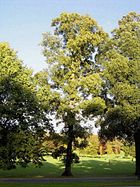- Ulmus minor subsp. angustifolia
-
Ulmus minor subsp. angustifolia 
Cornish Elm, Finistere, France, in 1996. Photo: Eric Collin, Cemagref
Scientific classification Kingdom: Plantae Division: Magnoliophyta Class: Magnoliopsida Order: Rosales Family: Ulmaceae Genus: Ulmus Species: U. minor Subspecies: U. minor angustifolia Trinomial name Ulmus minor subsp. angustifolia
Mill., (Weston), StaceSynonyms - Ulmus minor var. cornubiensis Richens
- Ulmus pyramidalis C. de Vos
- Ulmus stricta Lindley
- Ulmus suberosa fastigiata Audibert
Ulmus minor Mill. subsp. angustifolia (Weston) Stace , often known as the Cornish Elm, is a species of deciduous tree. The species was once a common sight across much of South West England, Southern Ireland and Brittany before the advent of Dutch elm disease, which devastated tree populations.
Contents
Description
Growing to a height of up to 27 m, this slender, slow-growing deciduous tree is distinguished by its long, straight trunk, culminating in a narrow fan-shaped crown comprising short, straight, ascending branches.[1][2]The leaves are small, obovate to oval, typically acuminate at the apex, 6 cm long by 3.5 cm broad with a dark-green upper surface, glossy and smooth. The reddish apetalous wind-pollinated flowers occur in clusters of between 15 and 20 on very short pedicels. The samarae rarely ripened in England, but when mature were very similar to those of the Field Elm group, being mostly obovate in shape and 16 mm by 10 mm in size.
Pests and diseases
Cornish Elm is very susceptible to Dutch elm disease, which devastated it in the United Kingdom.
Cultivation and uses
The origin of the Cornish Elm in the UK remains a matter of contention; commonly assumed to have been purposely introduced from Brittany by humans, it is also considered possible that the species may have survived the Ice Ages on lands to the south of Cornwall long since lost to the sea.[3] Its current distribution owes much to man's activities, as it is the tree traditionally considered the best choice for providing shelter along the Cornish coast. Moreover, its timber was much prized for its strength, and commonly used in wheel and wagon construction.[4]
Few wild mature specimens are known to have survived the current Dutch elm disease pandemic in England [6], but suckers remain a common component of hedgerows, and thus the genetic resources of this subspecies are not considered endangered [7]. A prime example is the Great Elm of Rosuic, an ancient pollard elm which attained a d.b.h. of over 2.5 m before succumbing to disease, but is now producing suckers.[5][6] Again, like others of the species, propagation is almost entirely by suckers, which the tree produces copiously.[7][8]
Notable trees
As of 2009, two specimens of Cornish Elm are reputed to survive in East Sussex at Selmeston, near the footpath across the grounds of Sherrington Manor.[8] A small number of mature trees, with an average d.b.h. of 143 cm, survive at Castletownbere Cemetery in County Cork, Ireland.[9] Another specimen, believed to be over a century old, exists in Shoreham, Victoria in Australia.
Varieties
The notable botanist Ronald Melville considered Goodyer's Elm Ulmus minor subsp. angustifolia var. goodyeri a variety of the Cornish Elm.
Hybrids
It has been suggested that a variety of Ulmus × hollandica found mainly in Cornwall, Ulmus × hollandica 'Daveyi', is a natural hybrid between wych elm and Cornish elm.[10][11]
Cultivars
There are no known cultivars of this taxon (but see F. J. Fontaine's conjecture about the cultivar 'Atropurpurea'), nor is it known to be in commerce beyond Australia.
Accessions
- North America
- Arnold Arboretum. Acc. no. 17676, and acc. no. 328-81 (two trees).
- Bartlett Tree Nurseries. Acc. no. 96-2161, details unavailable.
- J. C. Raulston Arboretum, North Carolina State University, details unavailable.
- Europe
- Brighton & Hove City Council, UK, NCCPG Elm Collection [9]. 12 trees in Bear Road Cemetery, 2 in Hove Cemetery, and 2 along Queen's Park Road.
- Cambridge Botanic Garden [10], University of Cambridge, UK, as U. angustifolia var. cornubiensis, no accession details available.
- Australasia
- Royal Botanic Gardens, Sydney, Australia.[12]
Nurseries
- Australasia
References
- ^ Diagnostic photographs of Cornish elm in St Austell (Francis Frith Collection) [1] ; at Coldrenick, Menheniot (Elwes and Henry, The Trees of Britain and Ireland vol.VII, Plate 397 [after p.1933]) [2] ; in Zelah (oldcornwall.netfirms.com) [3]
- ^ Photograph of U. minor subsp. angustifolia in France, patrimoine-lacreche.pagesperso-orange.fr [4]
- ^ White, J. & More, D. (2002). Trees of Britain & Northern Europe. Cassell's, London.
- ^ Elwes, H. J. & Henry, A. (1913). The Trees of Great Britain & Ireland. Vol. VII. pp 1848-1929. Private publication. [5]
- ^ "Ancient Trees in Cornwall (third paragraph)". Cornwall Council. February 17, 2010. http://www.cornwall.gov.uk/default.aspx?page=13843. Retrieved May 5, 2011. "Based on a chapter written by Sue Pring in 'Glorious Gardens of Cornwall' published by the Cornwall Gardens Trust."
- ^ Rackham, Oliver, A History of the Countryside (London, 1986)
- ^ Richens, R. H. (1983). Elm. Cambridge University Press
- ^ Stace, C. A. (1997). New Flora of the British Isles, 2nd edition. Cambridge University Press
- ^ Mackenthun, G. L. (2007) The elms of Co. Cork - a survey of species, varieties and forms. Irish Forestry Vol 64, (1 & 2) 2007
- ^ www.cornwall.gov.uk/default.aspx?page=13849
- ^ Archie Miles, Hidden Trees of Britain, Ebury Press, 2007, p.17
- ^ Spencer, R., Hawker, J. and Lumley, P. (1991). Elms in Australia. Australia: Royal Botanic Gardens, Melbourne. ISBN 0724199624.
Categories:- Ulmaceae
- Flora of France
- Flora of Great Britain
- Flora of Ireland
Wikimedia Foundation. 2010.

